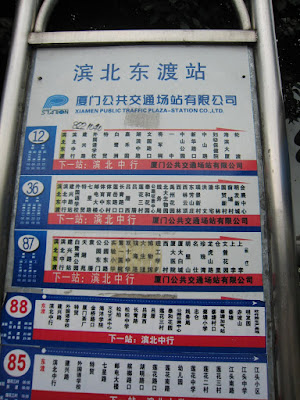I have mastered the bus system at this point. The bus stop near our apartment is at the end of the line, so we pretty much have reserved seats waiting for us in the morning. Additionally, the route for each line is posted. This is what it looks like -

When I first looked at it, I couldn't even tell which way to read it. Left-to-right or top-to-bottom or both.
Many buses here are air conditioned. Instead of 1 RMB, the fare is 2 RMB - double! - now that the air conditioning is running. I think that amounts to a carbon tax. Way to go, Xiamen! I doubt they are implementing any international global warming standards. No quantitative measurements are used to deduce how much pollution this extra air conditioning is generating. I think they just charge more, because it costs more.
This all sounds good, but it is, in fact, irrelevant for us. We take Bus 87 to the Xiamen University campus every day, which uses older buses that are not equipped with air conditioning. We'll see how we fare with all this humidity as the temperature climbs. The buses have quaint looking wooden seats.

We travel some of the main streets of Xiamen. One of the first landmarks we pass is the municipal auditorium with its sweeping grass lawn and flowers. On one side is a huge "statue", which I have dubbed the "Municipal Flower Pot".



Since Hilda's mother and nephew are visiting with us now, Hilda thought they might like to take the bus to the University and join us for lunch at one of the school cafeterias today. As it turned out, neither of them had ever ridden a public bus. They both grew up and live in Manila, in the Philippines, which according to Wikipedia is the world's fifth largest urban area by population. Manila has plenty of buses, and as I remember, flamboyantly decorated jeepneys (example of a jeepney). Hilda's mother had no desire to take her first public bus now, so they came by private car.
Our bus route takes us through a tunnel that winds underneath the Wanshi Botanical Gardens.


|

|
The bus passes some memorable sites on the University campus, including my favorite - the book fountain.

We get off at one of the seaside entrances to the University. Basically, we're at the beach. There are usually beachgoers and at certain times of day, there are a few swimmers. Since there are always large commercial vessels anchored at sea, I wouldn't hazard a swim in the water. There are also some islands that are usually shrouded in haze. The day after a rain, we could actually see them.


No comments:
Post a Comment